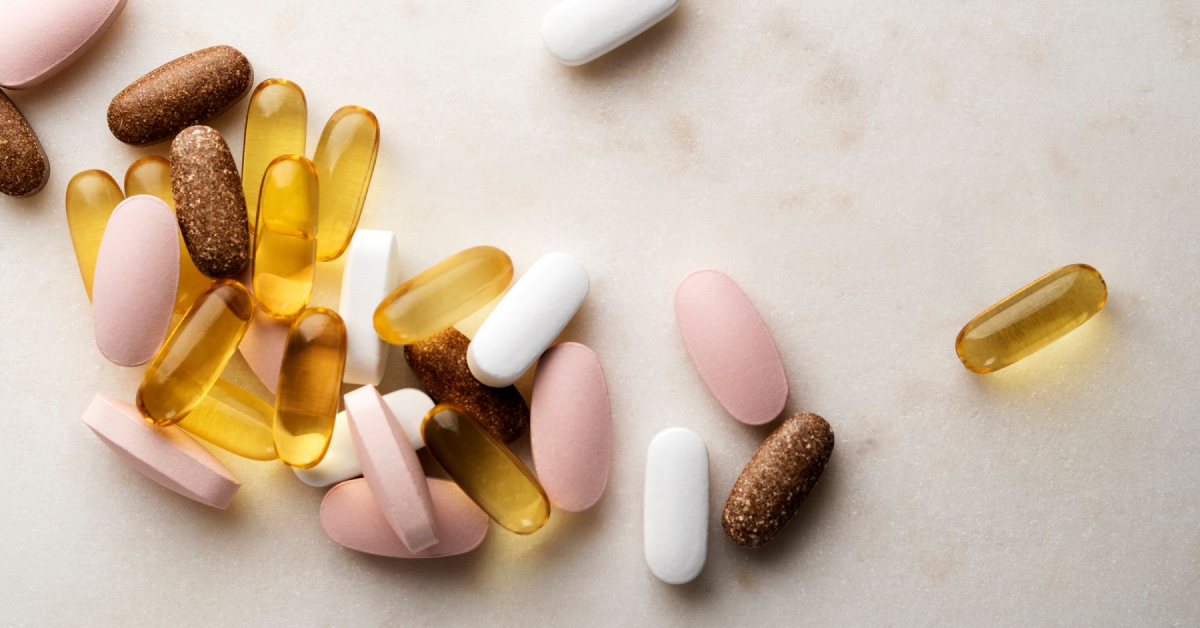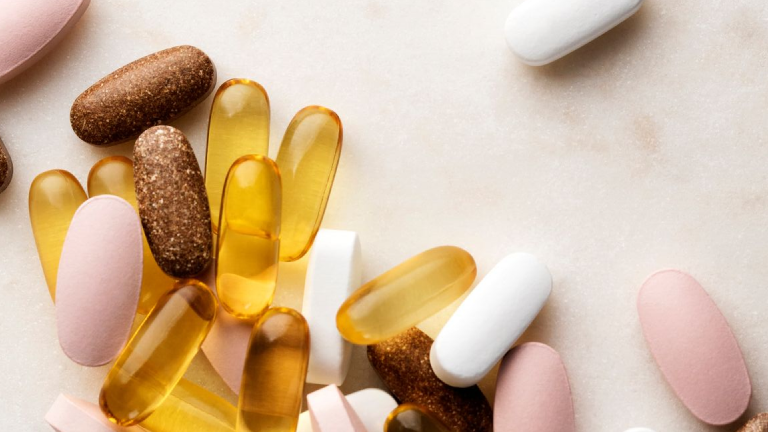Where do all the supplements go?


It’s a little after 7 a.m. and — after hitting snooze a couple times — you get up, wander into the kitchen for a glass of water, and take your calcium supplement. Sounds like a solid start to your morning, right? Once you swallow, it travels down your esophagus and into your stomach, where your stomach acid starts breaking it apart, separating the good stuff from any fillers. Once the calcium reaches your small intestine, it gets absorbed into your bloodstream. From there, it can travel to your bones, where it helps harden and strengthen them.
This part might be hard to swallow, though: However much calcium the supplement says it has, you only get roughly 35% of it by the time it gets to your bones. That’s bioavailability at work — essentially how much of a given nutrient actually gets used by the body. And it can vary according to the nutrient, the formulation, and whether it comes via liquid, pill, or powder. Even your age can impact how much of a supplement gets put to work. Here’s what you need to know to make the most of your daily dose.
What bioavailability actually means
Ever hear that your body doesn’t actually use supplements — but rather, you just pee them out? That’s not totally inaccurate, and bioavailability is a big part of that.
When you take a supplement, be it a multivitamin, mineral, probiotic, or herbal extract, the bioavailability describes how much of it your body actually absorbs and uses. “So, for example, if you take a vitamin C supplement, your body may only absorb about 30% of it — or 30% is bioavailable,” says Lauri Wright, Ph.D., the president of the Academy of Nutrition and Dietetics and a professor at University of South Florida. “That means the other 70% is excreted or not absorbed.”
But it’s not always as simple as taking a given amount of a nutrient to absorb a certain percentage of it. Rather, “there are so many factors that can affect that bioavailability, including the form of the supplement, the formulation, and even your gut health,” says Wright.
When it comes to macronutrients, which are your carbs, fats, and protein, bioavailability isn’t a big deal. These have high bioavailability whether you get them from a supplement or your food. “That’s because the body needs larger quantities of these nutrients and is very efficient at breaking down and absorbing them,” says Wright. And, she notes, if you get them in the form of protein powders or carbohydrate drinks, they’re already partially broken down, which can make them even easier to absorb.
What affects bioavailability
The time of day, size of the dose, your age, and your genetics can all impact bioavailability. Even your gut microbiome might increase or decrease bioavailability of nutrients (although the exact connections are unclear right now). Ultimately, a lot of it is out of your control. That said, these factors can still play a role.
The format
When you look at a shelf of supplements, you might see powders, liquids (or “drops”), gummies, and pills. But it’s not like there’s some hierarchy of efficacy in which one is hands-down better than the other, according to Wright. “Pills are very convenient, but sometimes they’re harder to digest because they're large or they're coated or they have a lot of fillers,” she says.
Meanwhile, even though powders tend to be absorbed more quickly due to their larger surface area, some nutrients aren’t easily compounded as powders due to their structure; that’s the case with fat-soluble vitamins like vitamins A, D, and K, which therefore work best housed in fats or oils, like in a capsule or as a drop.
Then, there are drops. “Liquid drops are often quickly absorbed and can bypass the digestive system and go into the bloodstream more quickly,” says Wright. However, many micronutrients can’t be formulated in a liquid form — so that can be a sticking point, too. (One example is probiotics, since the live bacteria need to be protected in a capsule.)
Here’s a look at the most popular supplements and how to get them:
- Powder: Protein, fiber
- Drops: Vitamin D, vitamin B12, vitamin K
- Pills: Green tea, calcium, iron
- Capsules: Omega-3 fatty acids (fish oil), probiotics
That said, what definitely should be lowest on your list is gummies. While bioavailability may be similar to other formats, they have the most additives, such as sweeteners so they taste good. For what it’s worth, chews fare slightly better. “Calcium chews are somewhat similar to gummies in that they’re chewable and flavored for palatability, but they beat gummies nutritionally, since they typically contain more calcium per piece than gummies and often include vitamin D to improve absorption,” says Wright.
The chemical structure
What makes more of a difference than the format is the chemical structure of the actual micronutrient, according to Dong Wook Kim, M.D., a board-certified internist at Massachusetts General Brigham who specializes in obesity medicine. Vitamins and minerals come in a ton of different variations; there are multiple types of iron, calcium, and selenium, for instance. Vitamin A is another good example. "There's betacarotene, which is plant-based. Its bioavailability is less than 50%," says Kim. "However, retinyl-based vitamin A has much higher absorption — more than 50%.” Because of that, it’s much more important to get the right type of the micronutrient than to have it be in a liquid or powder format.
Other micronutrients
Micronutrient pairings can also affect bioavailability — for better or for worse. Take iron, which pairs well with acidic foods like oranges and lemons. “When you package or when you consume some citrus with an iron-containing food, the acidity helps with the absorption,” says Wright. Strategic pairings include:
- Iron and vitamin C
- Calcium and vitamin D and K
- Magnesium and vitamin B6
- Zinc and vitamin A
On the other hand, some nutrients and medications can make micronutrients less bioavailable. A big one is aspirin. “Many people are recommended to take an aspirin every day, but it can decrease the availability of vitamin C,” says Wright.
What this means for you
Here’s the good news: While our bodies need micronutrients to support our health, they’re fairly easy to find in both food and supplement form. “B12 is a micronutrient, vitamin B1 is a micronutrient, vitamin D is a micronutrient, and so on,” says Kim. And, he says, they’re called micronutrients because our body doesn’t need much of them — so the fact that you’re not getting a 100% of your recommended daily allowance isn’t that big a deal.
But your better bet in terms of bioavailability — unless you want to go parsing the differences between calcium carbonate and calcium gluconate (which you certainly could) — is to get them via your whole foods if possible. That’s because you get both more micronutrients than just a standalone supplement, as well as other beneficial compounds like antioxidant-rich polyphenols.
In whole foods, nutrients “are often packaged in a way that we absorb them better,” says Wright. Let’s go back to the calcium example: If you drink cow’s milk, you’re absorbing more than 95% of the calcium in it — and also getting protein and vitamin D (assuming it’s fortified), she says. So there’s a clear advantage there.
That said, some nutrients can be tough to get from your diet alone. For instance, zinc tends to be hard to get, according to Wright. “Many Americans have some suboptimal intake, so they're not getting the average recommended amount,” she says. (They’re not outright deficient, but they’re still not getting the RDA; she suggests that it’s due in part to the reliance on ultra-processed foods, which tend to be low in nutrients.)
The same goes for vitamin B12: The bioavailability of vitamin B12 from dietary supplements seems to be 50% higher than its bioavailability in food sources, according to the National Institutes of Health.
Others include vitamin D; sunlight is the primary source. Otherwise, it’s found in fatty fish or fortified milk. “Because of the limited food sources of vitamin D, supplements are often needed,” says Wright. Iron is another common deficiency, especially among people who are menstruating or those adhering to a vegan diet.
The bottom line
If you want to take a supplement, the best way of getting it really depends on your personal preferences and needs. “In general, powders are ideal for people who need higher doses, want faster absorption, or have difficulty swallowing pills,” says Wright, who adds that they can also offer more flexibility in dosing. Meanwhile, she says, pills are convenient, portable, and have a longer shelf life. If you're more likely to remember to take a pill versus mixing a glass of water, then just do a pill. Do you love the taste of your calcium chews? Then stick with those.
And at the end of the day, if you’re worried that your diet isn’t cutting it, Wright says there’s no harm in taking a daily multivitamin. Bioavailability might be a nice thing to seek out, but at the end of the day, it’s not going to make or break your health.
This content is for informational purposes only and does not constitute medical advice, diagnosis or treatment. It should not be regarded as a substitute for guidance from your healthcare provider.
Calcium supplements: National Institutes of Health Office of Dietary Supplements (No Date). “Calcium Fact Sheet for Health Professionals.” https://ods.od.nih.gov/factsheets/Calcium-HealthProfessional/
